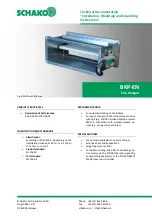
Page 3.111
6/20 IOM-CVRINST
Nailor Industries Inc. reserves the right to change any information concerning product or specification without notice or obligation.
Page No.
1. Installation
2
2. Maintenance
2
3. Adjustments
2
4. CVR-T Transition Installation
3
5. CVR-GM Grille Mount Installation
3
TABLE OF CONTENTS
INSTALLATION:
1.
The CVR can be installed in either a horizontal or vertical round duct. Make sure the "BAS" marking is facing down when
installed in a horizontal duct.
2.
The CVR is installed using the friction caused by the rubber seal around the edge. There is no need to use fasteners when
installing just the CVR to boxes, duct or duct collars.
3.
Install where there is access for future inspections.
4.
Avoid contact between the CVR and gypsum board.
5.
Install in accordance with required building and mechanical codes.
6.
Make sure the CVR is installed in the correct direction for desired airflow (exhaust supply).
MAINTENANCE:
The CVR does not normally require maintenance under standard conditions. However, we recommend installing with access
for cleanings and inspections to be safe.
ADJUSTMENTS:
The CVR can be adjusted to the desired airflow range using a bit Torx T10. Simply unscrew the set screw and move it up (to
decrease airflow) or down (to increase airflow), then re-screw set screw into place.
CONSTANT VOLUME REGULATORS - MODEL SERIES CVR
QUALIFICATIONS:
UL-2043 Listing: UL File #R38307
UL555 Listing: UL File #R9492
The CVD constant volume regulating damper is an extremely cost-effective way to precisely control the airflow of the HVAC
systems – especially high rise buildings - without the need for on-site electric or pneumatic controls or sensors. After manual
adjustment to a desired airflow range with a bit Torx T10, a self-regulating blade and spring piston adjust automatically to
maintain a constant set airflow volume. These dampers are designed to be operated in pressure ranges of 0.2" w.g. to 0.8"
w.g. They adjust automatically for variable duct pressures caused by building pressure, thermal stack effect, dust buildup and
other variable adverse conditions.






